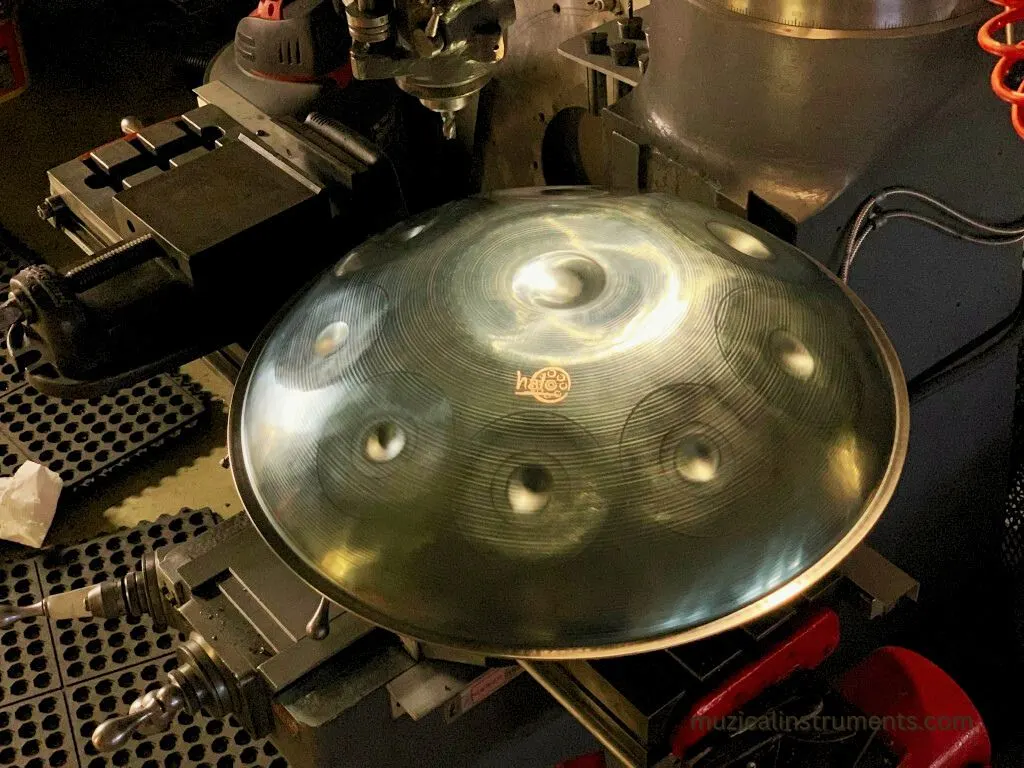What Is a Handpan and How Does It Sound?
What is a handpan? It’s a steel drum shaped like a UFO and has a round top and a hole underneath. The top has a big center called the ding. Around it are small dents. These are the tone fields. You tap them with your hands. Not sticks. Just fingers.
Each note sounds full and rich. That’s because every note holds three voices, a deep tone, a soft echo (called the octave), and a warm middle sound (called the fifth). The bottom hole, called the gu, helps the sound come out smooth and round.
Maybe you saw someone play one in the street. Maybe you heard one in a yoga class. And now you want to know more. This guide is for you. You’ll learn how handpans are made, how they sound, and how people use them for peace and healing.
What Is a Handpan Exactly?
What is a handpan? It’s a round steel drum. It has two metal shells stuck together. The top shell has one big note in the middle. That’s called the ding. Around the ding are small dents. These are the tone fields. Each dent makes a different note.
The bottom shell has a hole. It’s called the gu. The ‘gu’ helps air move. This makes the sound rich and smooth. When you hit the tone fields with your hands, the handpan sings. You don’t need sticks or tools. Just your fingers.
Each note has layers. It gives a deep tone, a soft echo (the octave), and a sweet ring (the fifth). The handpan is not like a normal drum. It plays both rhythm and melody. You can make music, even if you don’t know music.
Some handpans use nitrided steel. Some use stainless steel. These help the pan last longer and sound better. The steel is shaped, hammered, and tuned by hand. Makers take time to get the sound just right.
So, what is a handpan? It’s not just metal. It’s a voice. And it’s waiting for your hands.
How Does a Handpan Sound?
If you’re still wondering what is a handpan, listen closely, it’s not loud like a drum. It’s soft, smooth, and full of feeling. When you tap it, it rings like a bell. It hums like wind. It flows like water.
Each note has three parts. You hear the main tone, the octave, and the fifth. These mix together to make one rich sound. That’s why a handpan feels deep, even with just one tap.
The sound comes from the tone fields and the center ding. When you hit them with your fingers, they sing. The hole on the bottom, called the gu, helps shape the sound. It makes it round and full.
Different pans sound different. A handpan tuned in D minor feels calm or sad. One in C major feels bright and happy. Some scales feel like the ocean. Others feel like the stars. But all handpans give you peace.
That’s why people use them for yoga, meditation, and sound healing. The sound doesn’t just fill a room, it fills your heart.
How Is a Handpan Made?
To truly know what is a handpan, you need to see how it’s made. It starts as two round pieces of steel. Makers use either nitrided steel or stainless steel. These are strong and rust-free.
First, they shape the top shell into a dome. They press or hammer it into form. This is where they add the ding and tone fields. Each dent must be just right. Too soft? The sound is flat. Too hard? The note breaks.

Next, they shape the bottom shell. This is where they cut the ‘gu’, the round hole underneath. It helps the sound breathe and move.
Then comes the tuning. Makers tap each tone field by hand. They listen. They adjust. They shape the metal again and again. This step takes time. Some makers spend weeks to get the sound perfect.
The handpan is not made by machines. It’s shaped by hands, ears, and heart. That’s why no two handpans are the same. Each one has its own voice.
Where Did the Handpan Come From?
When you first asked what is a handpan, you may not have known it’s a new instrument. It only came to life in the year 2000.
It all started in Switzerland. A company called PANArt made the first one. They had already built steelpans before, drums from Trinidad and Tobago. But then they tried something new. They shaped the steel like a flying saucer and tuned it by hand. They named it the Hang®.
The Hang® was soft, smooth, and deep. People loved it. But PANArt didn’t make many. So other makers around the world began to create their own. That’s when the word handpan was born.
Now, many people play handpans. Makers build them in Spain, Germany, India, the UK, and more. Each one has its own sound. But the heart stays the same, warm, calm music played with your hands.
The Different Sounds You Can Choose
If you’re still thinking what is a handpan, here’s one key thing: each handpan plays one fixed scale. That means you can’t change the notes. So, picking the right sound really matters.
Some handpans use the D minor scale. It sounds deep and a little sad. Others use C major. That one feels bright and happy.
Each scale has its own mood. Some feel dreamy. Some feel dark. Others feel hopeful or playful. You can pick the one that fits your heart best.
You don’t need to learn chords or keys. Just choose a handpan that speaks to you, and let it sing.
Pick Your Perfect Handpan Sound
| Scale Name | Mood / Feel | Best For |
|---|---|---|
| D Minor | Deep, Sad, Dreamy | Meditation, Reflection |
| C Major | Bright, Happy | Joyful Play, Beginners |
| Celtic Minor | Calm, Peaceful | Yoga, Relaxation |
| Hijaz | Mysterious, Exotic | Storytelling, Emotion |
| Kurd | Earthy, Warm | Sound Baths, Nature Vibe |
How Do You Play a Handpan?

So now you know what is a handpan. But how do you play one?
You don’t need sticks. You just use your fingers. Light taps. Soft touches. Not hits or bangs.
Start slow. Feel the rhythm. Let your hands flow. You don’t need to know music. You don’t even need to count beats. The sound will guide you.
Want more help? You can try online lessons. A good place to start is MasterTheHandpan. They teach you step by step. You can also try mallets or light sticks for a new feel, but hands are best for the true sound.
Anyone can play. Kids. Adults. First-timers. You just need two hands and a little time.
Why Do People Love the Handpan?
You asked what is a handpan. But maybe the better question is, why does it touch so many hearts?
People love the handpan because it feels calm. You don’t need to be a drummer. You don’t need to read music. You just sit, play, and breathe. That’s why many people use it for meditation, sound healing, and yoga.
The sound is rich and soft. It helps with stress, sleep, and focus. Even kids can play it. Even older folks enjoy its peace.
The handpan isn’t loud or wild. It’s not built to show off. It’s built to connect, with yourself, with nature, with others.
Each handpan is tuned to a scale. Some sound bright, like C major. Some feel deep, like D minor. Some scales feel sad. Some feel happy. You choose the one that fits your heart.
That’s why people fall in love with this strange steel drum. It’s more than an instrument. It’s a friend.
Many people often confuse handpans with other percussive instruments. To learn about steel tongue drums, visit our dedicated guide.”
Thinking About Buying One?
By now, you understand what is a handpan. Maybe you even want to own one. But where do you start?
First, check the scale. Pick a sound that feels right to you. Happy? Calm? Deep? Remember, each handpan plays only one scale.
Next, look at the material. Many pans use nitrided steel or stainless steel. Some last longer. Some sound softer.
Make sure the handpan is tuned well. Good tuning means clean notes, no buzzing, and rich overtones. Always listen before you buy.
Know your maker. Some trusted names are Saraz, Yishama, Ayasa, and Halo. These builders have heart, and skill.
Prices? They start around $1,000. Some go up to $3,000 or more. That may feel high, but remember: each one is made by hand.
If you’re new, look for beginner-friendly sellers. Some even rent handpans or offer starter packs. You don’t have to rush.
Take your time. Trust your ears. Let your hands decide.
Beginner’s Guide to Handpan Brands & Materials
| Brand | Material | Price Range | Made In | Known For |
|---|---|---|---|---|
| Saraz | Nitrided Steel | $1,500–$2,500 | USA | Balanced Tone, Pro Tuning |
| Yishama | Stainless Steel | $2,000–$3,000+ | Israel | Rich Sound, Artful Design |
| Ayasa | Nitrided Steel | $1,000–$1,800 | India | Affordable, Great for Starters |
| Halo | Stainless Steel | $2,000+ | USA | Deep Voice, Strong Resonance |
FAQ
1. What is a handpan, in simple words?
A handpan is a round steel drum. You play it with your hands. It sounds soft, calm, and peaceful. This answers the fundamental question of “what is a handpan.”
2. Can I change the notes on a handpan?
No. Each handpan has one fixed scale. You can’t add or change notes. So pick one that fits how you feel. Understanding “what is a handpan” also means understanding its fixed nature.
3. Do I need to learn music to play it?
Nope! You don’t need to know any music theory. Just tap with your fingers. Feel the rhythm. It’s all about play.
4. What’s the best handpan scale for beginners?
Most people love D Minor or C Major. D Minor feels dreamy and calm. C Major sounds happy and bright. Both are great places to start for anyone wondering “what is a handpan” that’s easy to begin with.
5. How do I take care of my handpan?
Keep it dry. Don’t leave it in sun or rain. Wipe it after playing. Store it in a soft case. Some pans also need oil to prevent rust.
6. What is it made of?
Most are made of nitrided steel or stainless steel. Stainless steel lasts longer and doesn’t rust easily.
7. Why is a handpan so expensive?
Because it’s made by hand. Makers shape and tune each note carefully. A good handpan takes time and skill.
8. Where should I buy a handpan?
Buy from trusted makers like Saraz, Yishama, Ayasa, or Halo. Always listen to sound samples first. Some sites also rent them. Knowing “what is a handpan” is one thing; knowing where to get a quality one is another.
Final Thoughts: Let the Sound Speak
So, what is a handpan? It’s more than steel. It’s more than music.
It’s a feeling you can hold. A calm you can hear. A voice that comes from your hands.
You don’t need fast fingers. You don’t need rules. You just need a moment to listen. And a little space to play.
The handpan is not loud. It doesn’t shout. It sings, soft, slow, and true.
Let the sound speak to you. If it feels right, follow it. That’s where the music begins.
